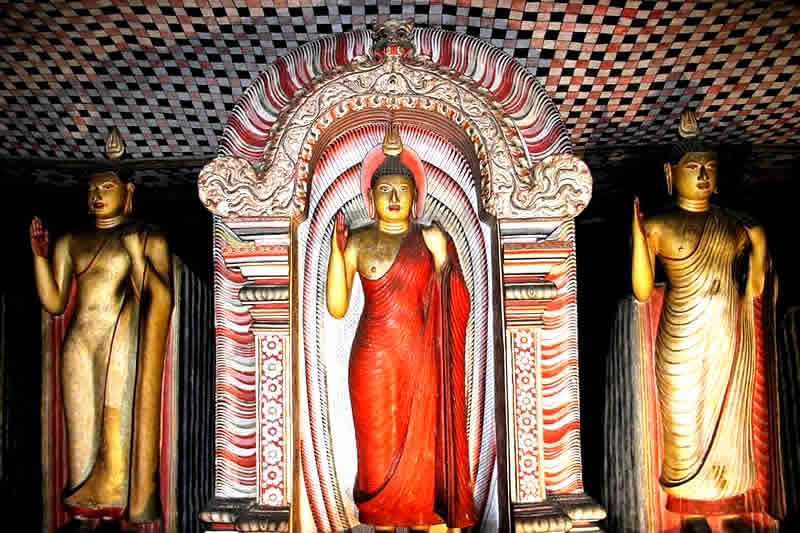Kalugala Aranya Senasana
Kalugala Aranya Senasana
Kalugala, which is located bordering the Sinharaja rain forest, is a popular meditation centre in Sri Lanka. It is a place that provides necessary seclusion, calmness and pleasant surroundings to carry out the meditation. Kalugala Aranya Senasana is a part of the Kalugala forest reserve, which is categorized as a lowland evergreen rainforest of Sri Lanka. Kalugala Aranya senasana is visited by Sri Lankan Buddhist devotees but it is difficult to see foreign travellers here. Because it is not included in most Sri Lanka road trips meant for foreigners.
Sri Lanka budget tours
Kalugala Aranya Senasana is the name of the meditation centre and Kalugala means “Black Rock” in the native language while Aranya Senasana denotes the Buddhist temple in a remote place. There is a large number of Aranya Senasana on the island; one distinct characteristic of these places is seclusion, away from the populated area. Being away from human habitation provides a suitable environment for meditation.
- Golden Temple of Polgahawela, Mahamevnawa
- Beautiful Temples In Colombo-Gangarama
- Anuradhapura Temple Sri Lanka
- Buddhist temple Devanagala
- Kataragama Temple
- Places to visit in Dambulla Cave temple
- The Buddhist Temple With the Largest Stone Structure in Sri Lanka
- Hinda Gala Cave Temple
- Munneswaram Temple
- Dimbulagala Temple Sri Lanka
- Gadaladeniya temple, Lankathilaka, Embekke temple
- Naguleswaram Hindu Temple Sri Lanka
- Paintings of Sri Lanka, paintings of Kelaniya temple, Sri Lanka
- Temple Of The Tooth Relic Kandy
- Historical Temple of Mulgirigala
Visiting Kalugala temple
It is visited by only a few visitors every day; some of them start their journey from very remote areas such as Kandy and Anuradhapura. The difficult long journey could not keep the devotees away from this religious place.
Visiting this Buddhist hermitage is a totally religious affair. However, it is more like a Sri Lanka jungle tour than a Buddhist pilgrimage. The visitors need to venture on an hour-long trek through the pristine vegetation on a trek, which is slightly wider than a footpath.
Kalugala Aranya Senasana came to be due to the endeavour of P.Samaradivakara Ralahamy in the 1940s. He had been a popular personality that engaged in various merit-making.
One needs to have a 2.5-kilometre-long trek to reach the monastery in the jungle. The footpath is very adventurous but needs caution due to the muddy, slippery surface. Colossal trees and vines, contrasting small trees, fascinating wildlife, insects, waterfalls, streams and rivers provide pleasure and excitement along the way. One can see a large number of small creatures such as crickets, bugs, worms and ants resting on the foliage, with a keen eye.
Especial attention should be paid to keep the leeches away from you, one can apply Siddhalepa balm or soap on toes, ankles, and hands before starting the walk. The area is inhabited by many rare species of butterflies as well. The diversity of avian fauna is considered to be high in the area, Sri Lanka jungle fowl (Gallus lafayetti), the island’s national bird, which is endemic to the island, is very common here.
An Ambalama or the traditional resting place halfway to the track provides the opportunity for relaxation and refresh before the second half of the footwork. Main Aranya Senasana is located on top of the mountain that has a building to accommodate the devotees who wish to make the overnight stay and prepare the Dana or almsgiving, for the resident monks. The devotee needs to maintain the calmness of the surroundings, otherwise, they would disturb the meditating monks.
The living quarters or Kuti are situated more towards the jungle. The area is reserved for monks for meditation and devotees have no access to the area. The main building is visited by the monks in the early morning for the morning Dana and again before noon for the midday Dana. These are the only occasions that devotees get the opportunity to see the monks.
The road that leads to the Kalugala Aranya Senansana goes through the tea plantations, picturesque countryside, mountains, streams, huge boulders, and escapement giving the visitors breathtaking scenery all along the way. The scenic drive is similar to the journey from lowland Sri Lanka to central highland destinations such as Bandarawela, Ella, Nuwara Eliya, and Haputale.
Being a part of the Kalugala rain forest, it records a very high annual rainfall every year and the area is full of streams and waterfalls. One can see a large variety of trees and plants here such as Coconut plantations, Tea plantations, Rubber trees, patches of forests and wetlands are prominent.







